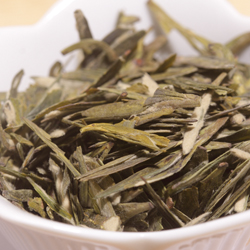A specialty of China's Fujian Province, white tea is the most
minimally processed of all the tea types. White teas were once reserved
exclusively as imperial tribute teas and are divided into two types: 1) those
made entirely from leaf buds that are covered with whitish hairs such as Silver
Needle and 2) those made from a mixture of both buds and leaves such as White
Peony.
White tea is made usually from a particular type of tea plant known
as the Da Bai Hao tea bush and is picked in early spring. Unlike green tea which
is heated at high temperatures after picking, white tea is air-dried, either in
the sun or at low temperatures indoors. This helps to preserve the tea
polyphenols. The natural drying process also causes the tea to oxidize very
slightly. After natural drying, the leaves are sorted so that only the whole
buds and leaves are preserved. The result of this processing is a tea with a
delicate aroma, natural sweetness and refreshing, savory taste.
White Tea - 3 Different Styles
Silver Needle
The origin of Silver Needle dates from the late 18th Century. It was
produced exclusively as a tribute paid to the Qing Dynasty emperor. This highly
prized white tea, entirely hand-picked during the early spring, is made only
from tender new buds that are covered in silver-white hairs. When infused,
Silver Needle tea produces a clear, straw colored liquor with an aroma of
fresh-cut hay and flowers. The taste is both vegetal and sweet with a note of
fresh summer corn. Its long finish is soothing to the palate.
White Peony
Our White Peony is picked in the early spring and carefully crafted
from a mix of light and dark green leaves and lots of silvery buds. White Peony
has a fresh bamboo aroma, a full-bodied mouth feel and a lightly sweet flavor
with notes of melon and grape. Refreshing and cooling, White Peony pairs well
with most foods and is especially good with sweets.
Darjeeling Silver Tips
This white tea from the award-winning Makaibari Estate in Darjeeling is a
rare treat for tea lovers. Hand-picked from special bushes, Silver Tips tea is
made only from young buds and tender leaves. Careful processing by the tea maker
results in an excellent tea with a delicate floral bouquet and notes of vanilla
and honey













